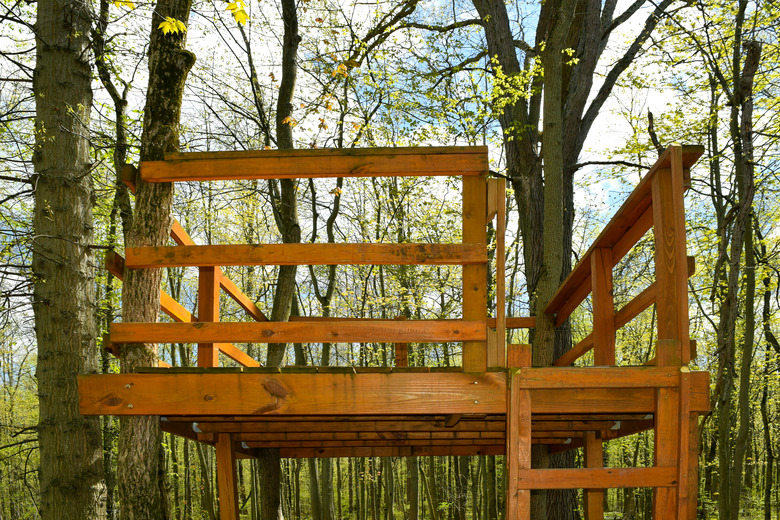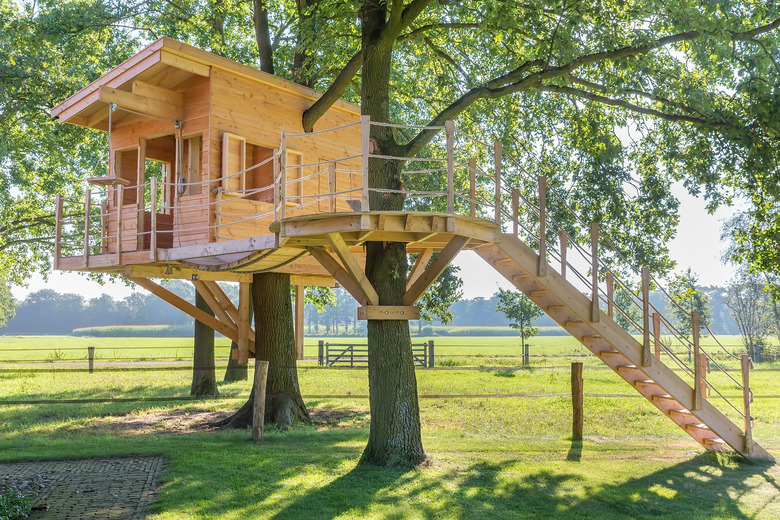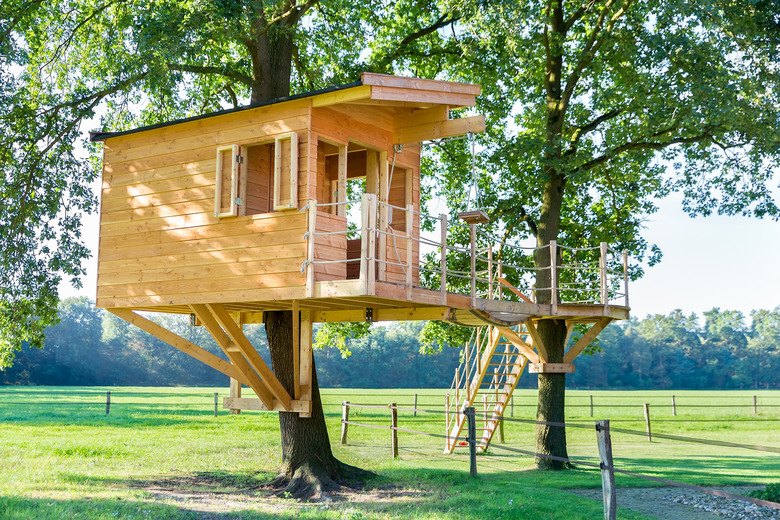Building A Treehouse Platform: A DIY Guide
We may receive a commission on purchases made from links.
Every treehouse project starts with a treehouse platform, and because trees move, a platform in a tree presents special challenges that you don't encounter on the ground. Trees get wider and taller as they grow, and they sway in the wind, so for a DIYer or a professional builder, a tree trunk or branch is somewhat of a moving target for bolts and other fasteners. Builders have plenty of options for flexible connectors that keep beams and joists firmly attached while allowing for tree movement, however.
Another problem to consider when attaching beams and joists to tree trunks and branches to build a treehouse platform is that fasteners hurt the tree. Fortunately, most trees can handle the wounds but only if you're careful about what type of fasteners you use and where you put them. A tree overloaded with fasteners, especially screws and nails (which experienced treehouse builders avoid), can develop a patch of deadwood that loses its grip on the fasteners, and the platform can fall.
Once you consider the issues associated with attaching wood to living and growing tree trunks and branches, building your own treehouse platform is similar to building a floating deck. The amount of support it needs depends on its size and expected load, and its configuration depends on the trees into which it's built. Like any good deck, it should be built with weather-resistant decking and coated with a protective finish to make it last.
Treehouse Platform Styles
Treehouse Platform Styles
Because it's built to specifications established by the trees to which it's attached, every treehouse platform is different, but each one rests on level joists and beams that are supported by one or more tree trunks or branches or by posts. The construction method varies with the scenario, and there are two common ones:
- Two beams attached to a single tree trunk: When a single large tree is available with a straight, branchless trunk, you can take advantage of it in two ways. One is to attach one or two 2x10 pressure-treated beams to opposite sides of the trunk, build a platform frame of joists on top of the beams and support the edges of the platform with diagonal knee braces that are anchored to the trunk underneath the platform. Another is to support the edges of the platform with 4x4 or 4x6 pressure-treated posts resting on concrete pier blocks or buried in concrete.
Because a single tree trunk is a fixed substrate and you don't have to worry about movements relative to what you attach to it, you can attach the beams and braces with lag screws. They should be beefy — a minimum diameter of 3/4 inch is recommended — and they should be long enough to sink into the heartwood on the middle of the trunk. Lag bolts are better than carriage bolts that penetrate the trunk because they only create one wound for the tree to heal.
- One or more beams is attached to two tree trunks or two branches of the main tree: When you support a beam from two trunks or branches that move relative to each other, you have to uncouple one end of the beam with a flexible connector, such as a treehouse attachment bolt (TAB) or a cable. A tree trunk develops enormous shear forces when the tree sways, especially near the ground, and the forces are strong enough to pull out conventional fasteners.
Once you know how to build a treehouse, you might try more complex projects that involve anchoring the platform to three or more trees or limbs. Every tree you add is an extra moving part that complicates the overall design, though, so it's worth it for your own safety to have your treehouse plans and your work inspected by a pro.
Types of Treehouse Platform Fasteners
Types of Treehouse Platform Fasteners
You'll need a number of different types of metal brackets and attachment bolts to secure the beams or joists of your treehouse platform to the tree. These obviously must be corrosion-resistant and made of heavy-gauge steel to make the likelihood of failure negligible. Some of the fasteners you might need include:
- Knee-brace support brackets: Knee braces extend diagonally down from the platform and are bolted to the trunk. A knee-brace bracket, which is bolted to the trunk with a single 1-inch-diameter or larger lag bolt, provides a flat surface for the end of the brace to rest against and holes for screws so you can secure the brace to it.
- Sliding brackets support joists and beams securely while still allowing freedom of movement. The J-bracket is open-ended, while the box bracket is closed, and both are suitable for small platforms with light loads. You usually have to protect the part of the wood resting on the bracket with steel to prevent it from wearing, and you also have to grease the bracket periodically to prevent squeaking.
- Treehouse attachment bolts (TABs) are extra-large lag screws with screw threads on both ends. You screw the lag screw end into the tree, slip a closed bracket onto the other end and screw on a large nut. When you screw the beam or joist to the bracket, it's supported by the bolt but has freedom of movement in two directions, and the nut prevents it from falling off the end of the bolt.
- Treehouse cables offer an alternative to J-brackets and TABs for providing a flexible connection when securing both ends of a beam to different tree trunks or branches. The cable is typically connected to an overhead branch by means of an eye hook or bracket and either wraps around the end of the beam or is connected with another bracket. Cables offer the ultimate in freedom of movement, and many builders use them extensively.
Spacing Fasteners in Treehouse Building
Spacing Fasteners in Treehouse Building
When you drive a screw or a bolt into a tree, it handles the wound by compartmentalizing it, which means it isolates the wound and grows around it. This usually doesn't create any problems when you drive a single screw or bolt, but if you drive several close together, the tree may treat all of them as a single wound and compartmentalize the whole area. As a result, the wood holding those fasteners dies and decays, and the fasteners eventually fall out. The tree isn't any happier about this than you are.
To prevent this from happening, you need to space screws and bolts by at least 12 inches vertically and horizontally. That means knee braces should not be butted against the trunk and attached with screws, and when you use knee-brace brackets, they should be attached to the trunk at different heights to maintain the proper separation between bolts. If your treehouse design calls for an array of knee braces radiating out from a central point like a flower, you should rethink it because that would call for several bolts within a short distance of each other. The tree will suffer, and ultimately, the bolts will probably fail.
Treehouse Platform Construction
Treehouse Platform Construction
The details of your platform construction depend on how many beams or joists you are able to secure to tree trunks or branches and the distances between anchor points. In some cases, it's a good idea to triangulate a pair of beams attached to different trees or branches and build out from there. At the point where the two beams meet at an angle, they are both notched with wide notches that fit together to create a sliding joint that is not fastened.
The size of the beams depends on the distances they span as well as the loads they carry; 2x10 is typically suitable for spans up to 8 feet, and 4x6 should span up to 12 feet without sagging. Beyond that, you'll probably need 4x10 or 4x12. Most localities require building permits for treehouses, so when you submit your treehouse plans, the building department will verify your beam sizes and advise you if you need to increase them.
Once you've formed the perimeter of the platform and connected the perimeter joists with galvanized corner braces (the safest way to do it), the rest of the construction proceeds like an ordinary deck. Install 2x10 or 2x8 pressure-treated joists, hanging them from galvanized steel joist hangers and spacing them 16 inches apart as measured from their centers. Unlike that of a deck on the ground, the infrastructure is visible, so you may want to paint or stain all the wood to match your backyard treehouse before you assemble the platform. It'll be a lot easier than painting it in place.
The last ingredient is the decking itself, which can be 2x6 wood, composite planks or 3/4-inch pressure-treated plywood. Fasten this with 3-inch decking screws and you now have a solid base for your DIY treehouse. Don't forget to give the decking a protective finish; even if it is pressure treated, it will last longer up in the trees if you seal it.
Some Mistakes to Avoid When Building a Treehouse
Some Mistakes to Avoid When Building a Treehouse
Even more than when building on the ground, it's important to plumb and level every beam and joist with a spirit level before you attach it. You can't trust your visual judgement when working among the trees, and if you build your platform out of level, you'll complicate every aspect of your treehouse construction project. Check the level and then double-check it before you commit to fastening.
You need a way to access the treehouse platform, and your plans should include a stairway, ladder or other means of access. Don't plan on attaching a ladder to the tree even if you're building a simple platform for the kids. You'll hurt the tree by overloading it with fasteners, and even if the tree manages to recover, this type of ladder is seldom safe. If you want to provide a ladder rather than a stairway, give it a slope to make it easier for people using it to keep their balance and be sure to provide plenty of space at the top of the ladder to allow people to get off the ladder safely.
When using cables to support beams, make sure it's impossible for the tree to come in contact with the cables. If a branch can brush against a cable, it will gradually lose its bark, and eventually, it could die. Similarly, never wrap a cable or anything else around a branch or tree trunk, girdling the tree and cutting off the flow of sap. If the trunk or a limb passes through any part of your platform, be sure to leave a minimum gap of 2 inches to allow it to grow. Failing to give the tree room to grow is one of the most common mistakes made by DIY treehouse builders, who are often surprised by how quickly a tree can buckle wood decking.


